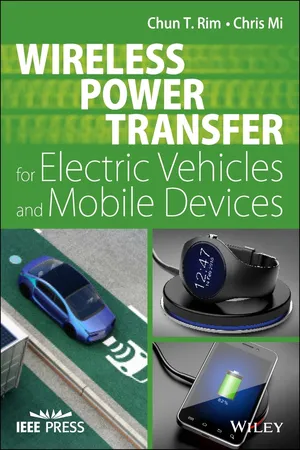
- English
- ePUB (mobile friendly)
- Available on iOS & Android
Wireless Power Transfer for Electric Vehicles and Mobile Devices
About this book
From mobile, cable-free re-charging of electric vehicles, smart phones and laptops to collecting solar electricity from orbiting solar farms, wireless power transfer (WPT) technologies offer consumers and society enormous benefits. Written by innovators in the field, this comprehensive resource explains the fundamental principles and latest advances in WPT and illustrates key applications of this emergent technology.
Key features and coverage include:
- The fundamental principles of WPT to practical applications on dynamic charging and static charging of EVs and smartphones.
- Theories for inductive power transfer (IPT) such as the coupled inductor model, gyrator circuit model, and magnetic mirror model.
- IPTs for road powered EVs, including controller, compensation circuit, electro-magnetic field cancel, large tolerance, power rail segmentation, and foreign object detection.
- IPTs for static charging for EVs and large tolerance and capacitive charging issues, as well as IPT mobile applications such as free space omnidirectional IPT by dipole coils and 2D IPT for robots.
- Principle and applications of capacitive power transfer.
- Synthesized magnetic field focusing, wireless nuclear instrumentation, and future WPT.
A technical asset for engineers in the power electronics, internet of things and automotive sectors, Wireless Power Transfer for Electric Vehicles and Mobile Devices is an essential design and analysis guide and an important reference for graduate and higher undergraduate students preparing for careers in these industries.
Frequently asked questions
- Essential is ideal for learners and professionals who enjoy exploring a wide range of subjects. Access the Essential Library with 800,000+ trusted titles and best-sellers across business, personal growth, and the humanities. Includes unlimited reading time and Standard Read Aloud voice.
- Complete: Perfect for advanced learners and researchers needing full, unrestricted access. Unlock 1.4M+ books across hundreds of subjects, including academic and specialized titles. The Complete Plan also includes advanced features like Premium Read Aloud and Research Assistant.
Please note we cannot support devices running on iOS 13 and Android 7 or earlier. Learn more about using the app.
Information
Part I
Introduction
1
Introduction to Mobile Power Electronics
1.1 General Overview of Mobile Power Electronics


Question 1 (1) How can you classify electric shavers and vacuum cleaners that have a stretchable cable? (2) Are the items of (1) SPT or MPT? (3) What are the benefits of the classification of SPT and MPT? (4) Is there any fundamental distinction between SPT and MPT as well as IPT, CPT, RF PT, and Optical PT?
1.2 Brief History of Mobile Power Electronics
Table of contents
- Cover
- Title page
- Copyright
- Preface
- Part I Introduction
- Part II Theories for Inductive Power Transfer (IPT)
- Part III Dynamic Charging for Road-Powered Electric Vehicles (RPEVs)
- Part IV Static Charging for Pure EVs and Plug-in Hybrid EVs
- Part V Mobile Applications for Phones and Robots
- Part VI Special Applications of Wireless Power
- Index
- EULA